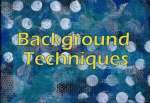
This technique is so simple! So easy that I could kick myself for not ’seeing’ it sooner! Its been staring at me in the face all along; still, better late than never huh!
This technique involves using clear packaging tape or heavy duty masking tape to actually LIFT off the image and use it to make an impression or background.
There was several ways you can apply the tape lifting technique. This tutorial will give you a run down through all of them.
Read on for details.
Getting Started – Tools Needed For Tape Lifting
The first thing you need is Wide Clear Packaging Tape; you can use any size tape but I prefer to go for the widest as you can lift bigger images and your not as limited.
Heavy Duty Masking Tape; you want the strong stuff not the low tack variety. I got some super duper sticky stuff from poundlands.
Next you need Printed Papers to tape lift from; Newspapers are perfect for this because they are so thin. You can use book pages too from cheap paperbacks, I use the pages from books I get free on magazines for this purpose. Magazines are also ideal.
You will also need Rubber Stamps of your choice and a good Black Permanent Dye Inkpad (for example memories).
Lastly you need ordinary White Card to transfer your tape lifts onto; you can use any colour you wish, I just prefer to use white so I can add my own colour afterwards.
Which Tape Is Best For Tape Lifting?
You can work with either masking tape or clear packaging tape for all these techniques below, they are both ideal and both create very different effects. It depends on the overall look you are aiming for. Clear tape creates a more striking effect where the masking tape creates a very subtle muted effect. Try them both and compare.
Creating Tape Lifting Backgrounds:
For the tape lift backgrounds you need either the masking tape or the clear tape, the directions are the same no matter what type of tape you opt for.
1. Tear off a small strip of tape, gently rub it across newspaper or paperback paper print, do not rub too hard, quickly lift off the tape, then press the tape lift image directly over the top of the white card stock (leaving the actual tape and image on the card itself)
The trick is to remove the tape without removing too much of the paper with it. If you practise this step you will get used to pressing and lifting the text and not the paper. Cheap quality papers work best for this I found like freebie magazine supplements, newspapers and free paperbacks.
2. Continue tape lifting text from various papers until you have completely covered the surface area of your card. When sticking the tape on the card; arrange the tape lifts so that they are showing at all different angles and directions.
Dont worry about completely covering the background with print, it is ok to have blank areas! You can add blank tape inbetween the prints so that there is no break in the texture of the background itself.
When you’ve finished you will have something which looks a little like these samples:
Clear Tape Lifting Background:

Masking Tape Lifting Background:
The newsprint is still visible through the masking tape despite the masking tape being opaque….how cool is that 😉

As you can see from the above two scans that they are very different from one another! Talk about cool!
Adding Colour To The Backgrounds:
Because the clear tape lift backgrounds are glossy they are PERFECT for alcohol inks! Before adding colour I apply a layer of clear tape over the top of the tape lift prints so that the entire surface area of the card is completely covered with clear glossy tape. Then I add colour to the background using alcohol inks. The background below was created using Pinata inks:

To add colour to the Masking Tape Backgrounds I sponged on Dye Inks:

As you can see from the samples above that the 2 different tapes create 2 very different and yet striking effects!
Once youve made your backgrounds you can use them in your projects.
Tape Lift Stamping Technique
This technique involves using the tape to actually lift the image from your rubber stamp!
1. Ink your rubber stamp with black dye ink and place it face up on your work surface. I used Memories brand, the stamp used is part of the Tim Holtz Stampers Anonymous line.
2. Tear off a strip of tape; either clear or masking, and place it sticky side down over the top of the inked rubber stamp.
3. Very gently, rub your finger across the surface of the tape to transfer the ink, the sticky surface of the tape ‘grabs’ at the ink and doesnt slide or slip.
4. Quickly lift off the tape and press the image (and the tape) down onto card stock. Your tape lift stamped image is now transfered and ready for colour!
Note: Your tape lift stamped images will be a REVERSE image so dont use stamped images which rely too much on words (ie greetings) – if your using a word background stamp however the back to front lettering will give it a collagey feeling!


As before you can use alcohol inks with the clear tape or you can sponge on dye inks over the masking tape images.
Card Samples Using Tape Lift Stamping Technique:
Using Clear Tape:

Using Masking Tape:

This technique is really exciting and I love lifting the images of the stamps! The quality of the prints on the clear tape are awesome, far better than on acetate as the tape doesnt slip!
But thats not all!
Tape Lift Foiling:
Below are some samples I did using Tape Lift Foiling!! This technique is just like the tape lifting methods described above; only you use foil on the tape to ‘lift’ it off its protective backing sheet! Try it yourself and see…
Tape Lift Foiling Samples:



I hope you all enjoy playing with this technique and have as much fun with it as I did!If you have any questions or comments you can use the ‘add comments’ function below!
Trish
Additional Notes:
A few readers have asked me about the Masking Tape Lifting Technique on the comments form and how it works as they cannot understand how it could possibly work as the masking tape isnt clear.
Heres my response:
I know masking tape isnt clear and it is opaque or rather cream in colour, but believe me the tape lift technique DOES work with it! Seems to me people have not actually TRIED it to see, just commented that they ‘dont think it will work’ …..
Just place the tape onto either newspaper or onto an inked stamp, lift it off again then stick the masking tape onto a sheet of card. The image WILL be visible – not as strongly as it would be with clear tape but it IS there – just very subtle and slight. It looks especially good on vintage style images as it makes them look distressed.
TRY IT AND SEE FOR YOURSELF!































































